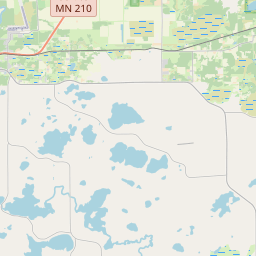Aitkin County Courthouse and Jail
Historical marker location:
217 2nd St NW, Aitkin, Minnesota
( Marker is on 2nd St NW, on the right when traveling east.)







© OpenStreetMap contributors
Loading...
Searching for other points of interest within 3 miles of this location.The first successful open-heart surgery was performed in 1952 at the University of Minnesota by Dr. C. Walton Lillehei.
About Aitkin County
Aitkin County Timeline
Aitkin County, located in the central part of Minnesota, has a rich and varied history that dates back thousands of years. The area was originally home to the Dakota and Ojibwe Native American tribes, who relied on the abundant natural resources of the region for their livelihoods. European exploration and settlement began in the 17th century, with French traders and voyageurs making their way to the area to trade furs with the Native Americans.
In the mid-19th century, the US government established a trading post in Aitkin County, which helped to facilitate further settlement in the area. The county was officially established in 1857, named after William Alexander Aitkin, a prominent fur trader in the region. The lumber industry soon became a major economic driver for the county, with numerous sawmills established along the area's rivers.
The construction of railroads in the late 19th century further spurred growth and development in Aitkin County. The county became a hub for logging and timber transportation, as well as providing a means for settlers to access the area. The county's economy diversified over time, with agriculture playing an increasingly important role alongside the timber industry.
Today, Aitkin County is a thriving community that embraces its natural beauty and history. Outdoor recreation, such as fishing, hunting, and hiking, is a popular activity in the area. The county's historical sites and museums, such as the Aitkin County Historical Society and the Aitkin Depot Museum, provide a glimpse into the area's past. Aitkin County continues to be a place where residents and visitors can appreciate the unique combination of natural resources and rich history that the region has to offer.
In the mid-19th century, the US government established a trading post in Aitkin County, which helped to facilitate further settlement in the area. The county was officially established in 1857, named after William Alexander Aitkin, a prominent fur trader in the region. The lumber industry soon became a major economic driver for the county, with numerous sawmills established along the area's rivers.
The construction of railroads in the late 19th century further spurred growth and development in Aitkin County. The county became a hub for logging and timber transportation, as well as providing a means for settlers to access the area. The county's economy diversified over time, with agriculture playing an increasingly important role alongside the timber industry.
Today, Aitkin County is a thriving community that embraces its natural beauty and history. Outdoor recreation, such as fishing, hunting, and hiking, is a popular activity in the area. The county's historical sites and museums, such as the Aitkin County Historical Society and the Aitkin Depot Museum, provide a glimpse into the area's past. Aitkin County continues to be a place where residents and visitors can appreciate the unique combination of natural resources and rich history that the region has to offer.
Aitkin County Timeline
This timeline provides a glimpse into the major events and milestones that have shaped the history of Aitkin County, Minnesota.
- 1857: Aitkin County is established by the Minnesota Territorial Legislature.
- 1871: Aitkin becomes the county seat of Aitkin County.
- 1884: The Great Northern Railway reaches Aitkin, connecting the area to larger markets.
- 1902: The town of McGregor is incorporated in Aitkin County.
- 1903: The Soo Line Railroad reaches Aitkin, further improving transportation in the area.
- 1930s: The Great Depression brings economic hardship to Aitkin County.
- 1942: The Savanna Army Depot is established near McGregor during World War II.
- 1970s: Aitkin County experiences a period of economic growth and development.
- 1993: The Pillsbury State Forest is established in Aitkin County.
- 2016: The Mille Lacs Indian Reservation, located partially within Aitkin County, is officially recognized by the federal government.